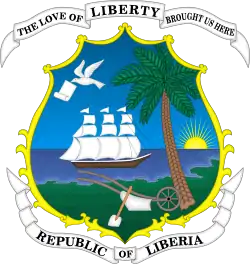Transport in Liberia
Transport in Liberia consist of railways, highways, seaports and airports.
| Republic of Liberia |
|---|
 |
| Subdivisions |
Railways
Historically, three railways were built in Liberia to export ore from mines; they were damaged during civil war. In 2010, only the Bong mine railway was operational[1] but the Lamco Railway was at least partially rebuilt by Arcelor Mittal and put back into service in 2011.[2] There are no rail connections with other countries, although there has been a proposal to extend the Bong mine railway to serve a mine across the border in Guinea.
Highways
Total: 10,600 km (6,586 mi) (there is major deterioration on all highways due to heavy rains and lack of maintenance)
Paved: 657 km (408 mi)
Unpaved: 9,943 km (6,178 mi) (2018)
When construction and reconstruction of roads in Liberia is complete, the Trans–West African Coastal Highway will cross the country, connecting it to Freetown (Sierra Leone), Abidjan (Ivory Coast), and eventually to 11 other nations of the Economic Community of West African States (ECOWAS).
Ports and harbors
- Buchanan - railhead of 1,435 mm (4 ft 8 1⁄2 in) standard gauge for civil war affected iron mine at Nimba
- Greenville
- Harper
- Monrovia
Merchant marine
Liberia is an international flag of convenience for freight shipping.
Total: 3,321 ships (1,000 GT or over)
Ships by type: barge carrier 1086, container ship 834, general cargo 130, oil tanker 723, other 548 (2018)
Airports
20 (2017) The main international airport in the country is Roberts International Airport.
Airports - with paved runways
Total: 2 Over 3,047 m (10,000 ft): 1 1,524 to 2,437 m (5,000 to 8,000 ft): 1 (2017)
Airports - with unpaved runways
Total: 27 1,524 to 2,437 m (5,000 to 8,000 ft): 5 914 to 1,523 m (3,000 to 4,999 ft): 8 Under 914 m (3,000 ft): 14 (2013)
See also
References
- "Track machine exports". Railway Gazette International. 2010-08-31. Retrieved 2010-10-25.
- Railways in Liberia, http://sinfin.net/railways/world/liberia.html
External links
- "LiberiaEntry". Fahrplancenter.com. Retrieved 26 October 2017.